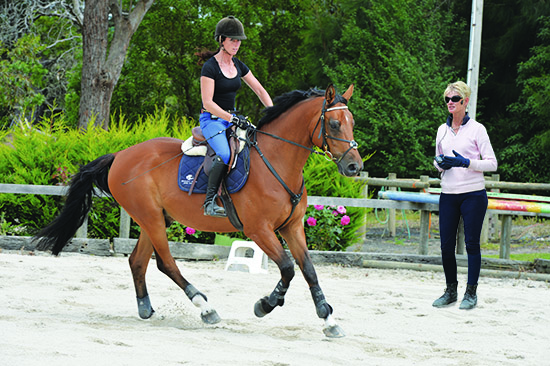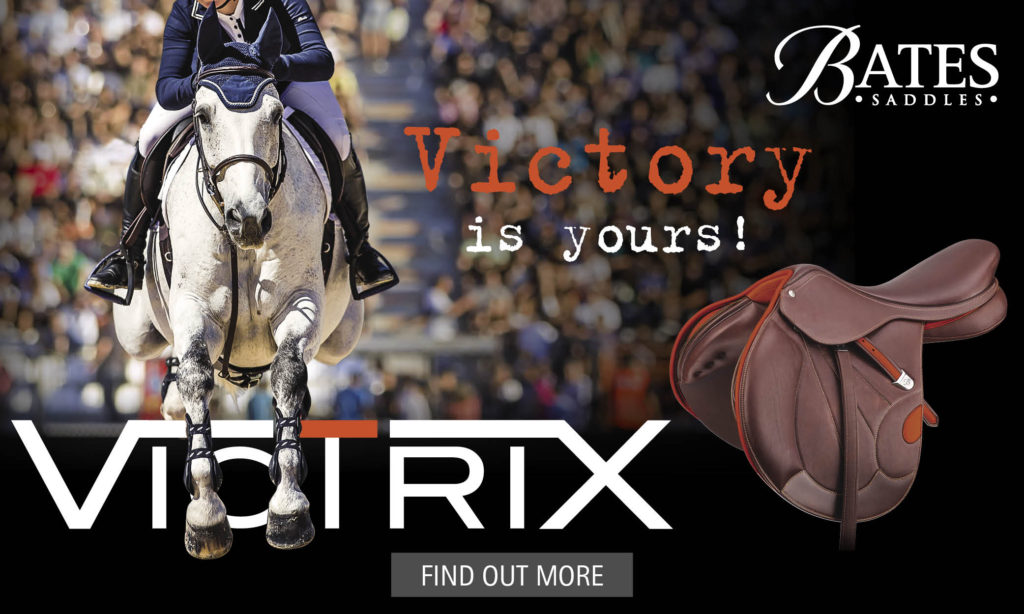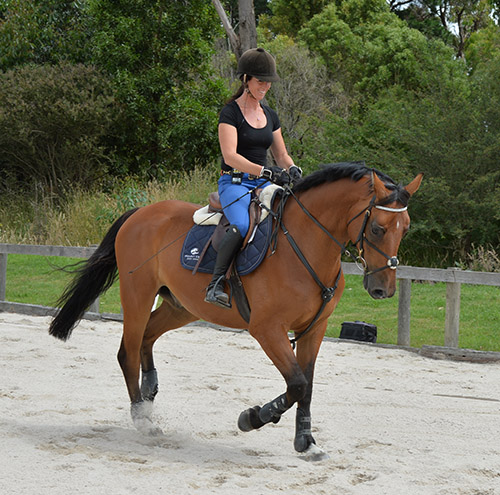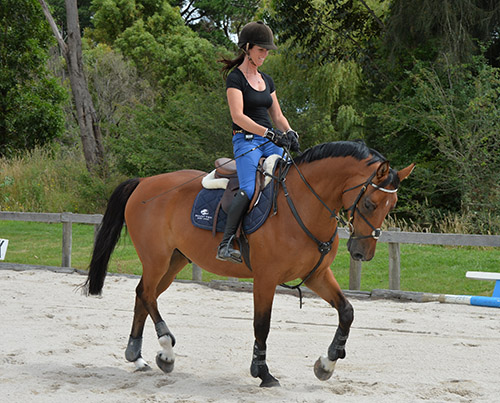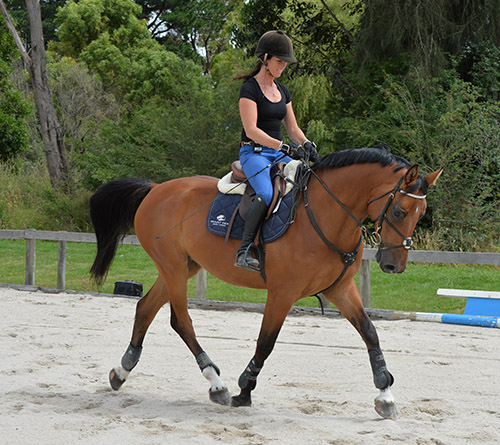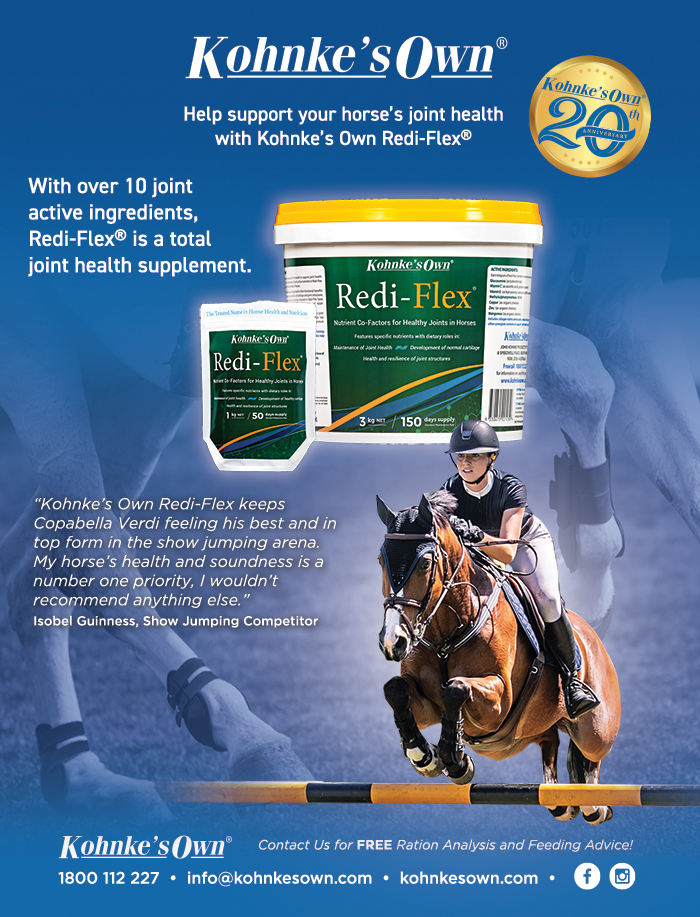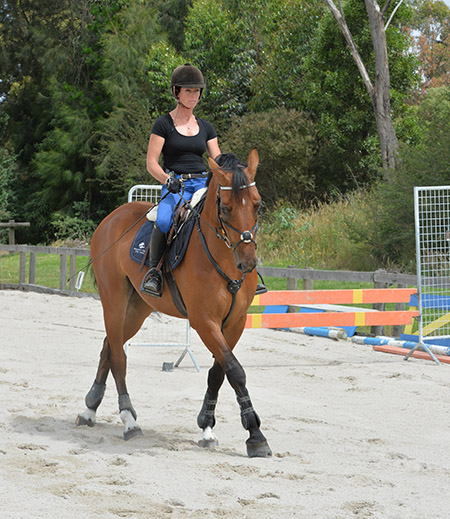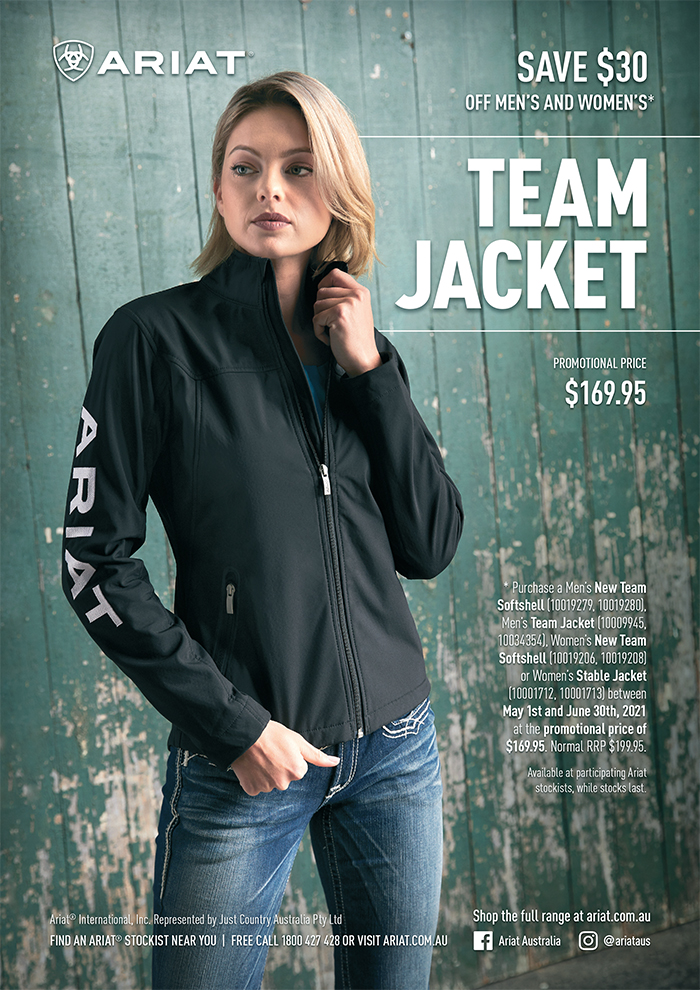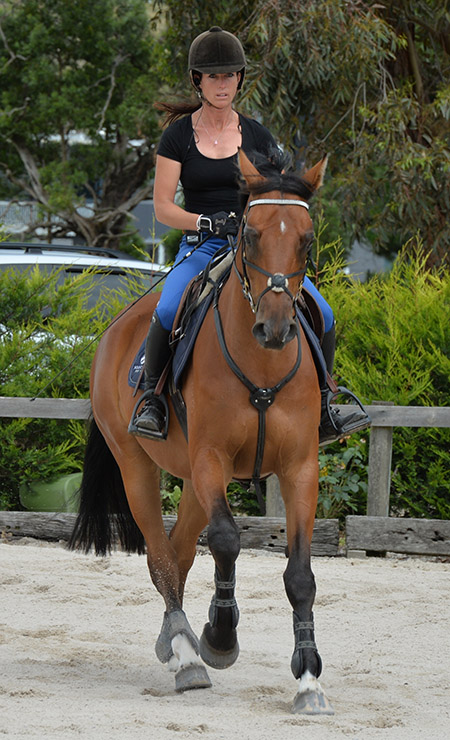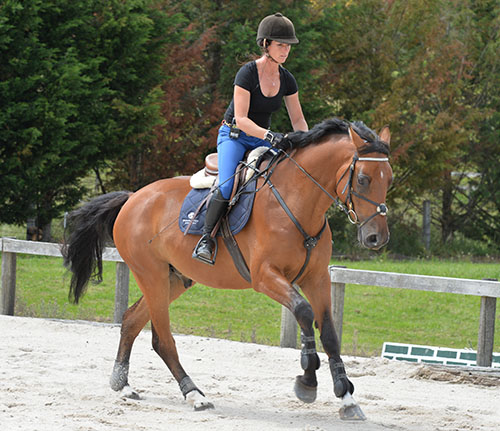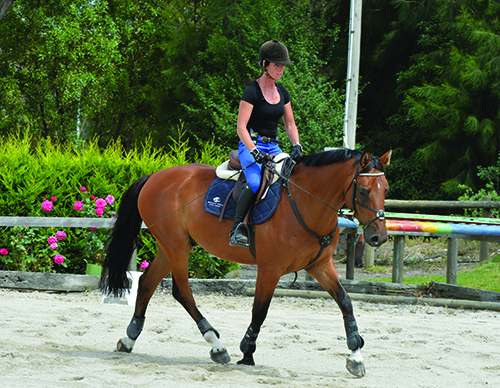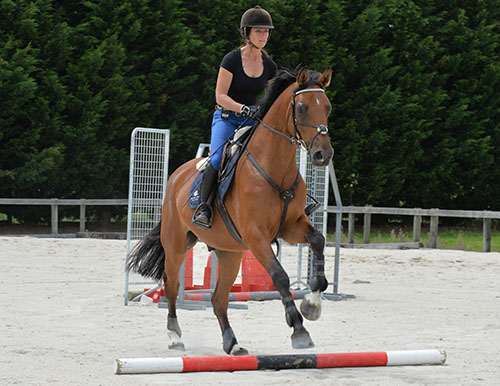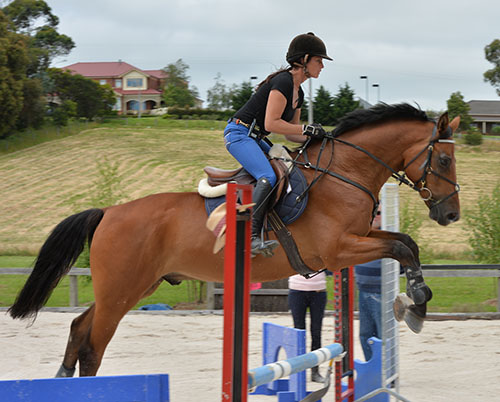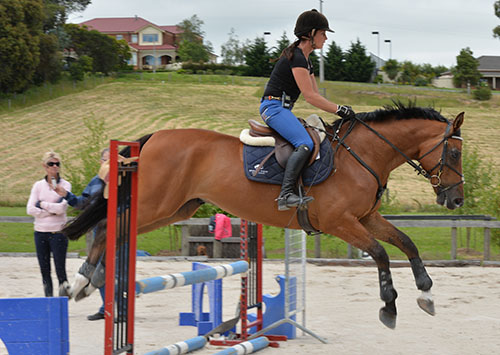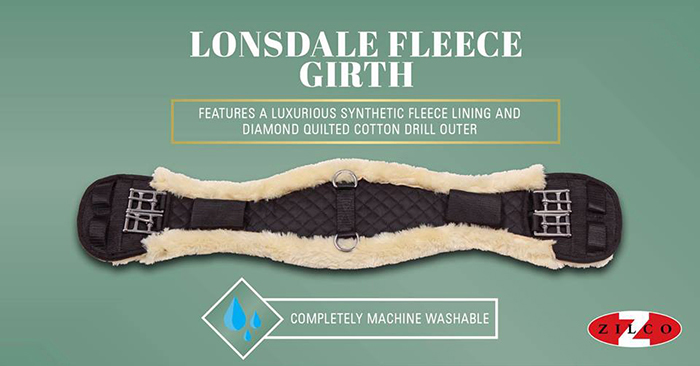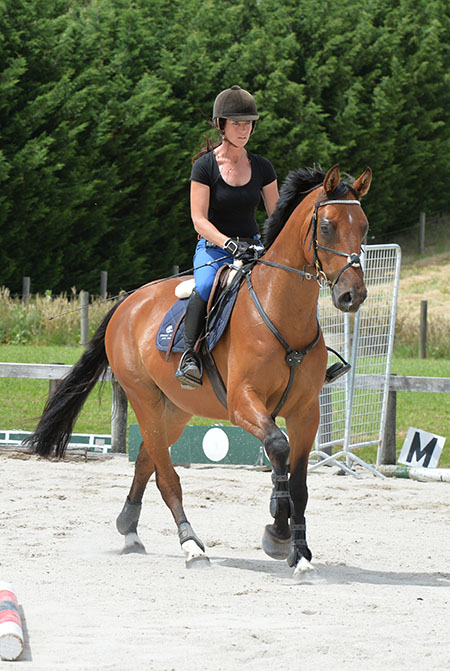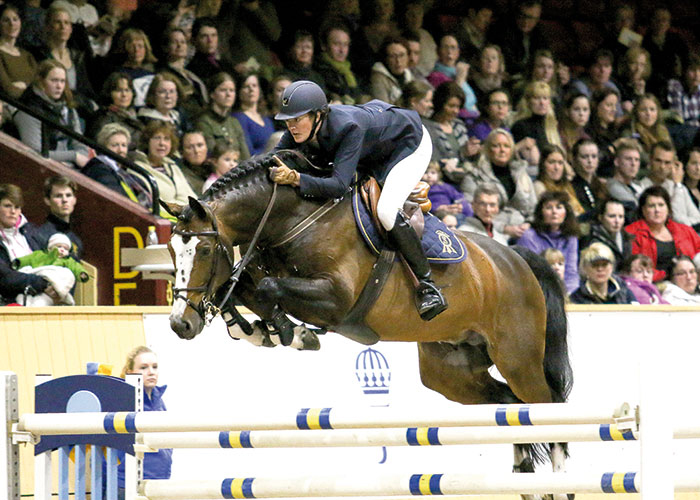Story Chris Hector & Photos Roz Neave
Since we started The Horse Magazine in 1984, we have run hundreds of articles on the much discussed and elusive ‘basics’. When the magazine started out, we would have interviews with trainers from Europe and when they told us, ‘your riders don’t have the basics’, and we asked for explanations, we would get elaborate words and descriptions which many of our readers found incomprehensible and conflicting. ‘I only go to trainer X because he gets my horse going well, trainer Y says something entirely different.’
Even at the top, at the Australian elite squad level, you will still find riders who have not learnt to produce a horse that is balanced and in self carriage, and that alas, includes some of our top ‘dressage’ riders…
Michelle Strapp is a genius at getting to the basics in her analysis and explanations when working with a rider. In this session with Caroline Price and her 5-year-old Warmblood, Finn MVNZ, Michelle talks about developing the rider’s awareness of the hind leg and how that changes the balance of the ridden horse.
First that half halt again…
Establishing the half halt
The bay is green, very green, and Michelle and Caroline are working on a couple of essentials – acceptance of the bridle, and in the words of the late, great, Franz Mairinger – ‘my speed, and my line’. When Caroline asks for a downward transition, the horse tends to resist the bit…
“When you ride a trot/walk transition, and you feel a resistance in the bridle, go forward again. First of all shorten the trot, go forward again…”
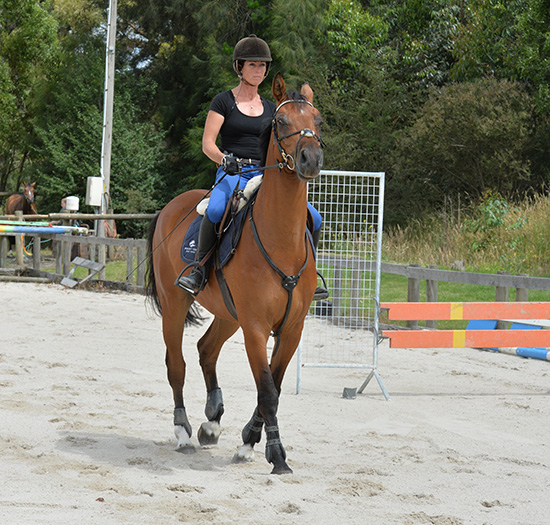
But the resistance in front is really a result of what is happening behind:
“If you go to the walk transition, can you feel that when you start to shorten the trot, the hind leg gets slow and falls behind you, and the horse drops it’s stomach to the ground. Let us start just doing the transition within the trot, until he starts to understand what we are doing. What I want you to do is as soon as you go to shorten, read the hind leg, and when the tempo of the hind leg gets slow, change your mind – change your mind, change your mind…”
“Go to shorten, forward and out of it straight away, as soon as you feel the hind leg get slow – forward, forward, you were too slow.”

“Think less hand, you need very little hand, all you have to do is shorten your rise, that’s enough, perfect. Now you have him more responsive to your leg – he needs to understand the half halt, we’ve got to give him that understanding so we can re-adjust his balance, and mould the forwardness you have created.. Perfect, now forward again.”
“Keep you hands very, very steady, go to shorten, slow your rise, that’s enough, go forward out of it, did you feel him drop away? As you teach him to lengthen and shorten at this stage, your reading of the speed of the hind leg is really important. He can only maintain his balance, if the speed of the hind leg is quick enough to carry his body.”
“If the hind leg gets too slow, then he drops down to the floor and that’s when you will hit the resistance in the bridle. You need to do thousands of those, go to shorten, forward again.”
“Because he doesn’t understand, he feels the bridle, and resists against the bridle. You’ve gradually got to get the hind leg quicker which allows him to use his power and carry himself. One of the ultimate goals in suppleness is a horse that bends its joints. You want him to have courage and confidence to go forward to your hand with that amount of power. Your hand is just to receive, you don’t want to use it as a hand brake.”
more on feel follows
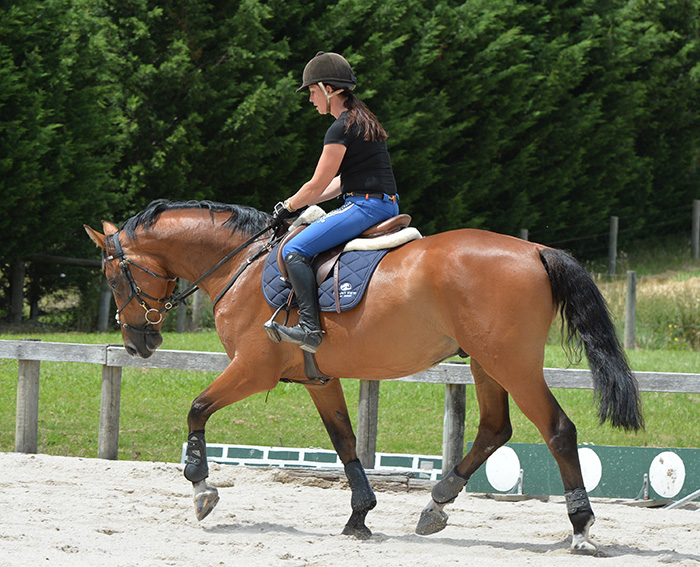
“Use your cluck, because his hind leg gets slower before you know it, go to shorten, cluck, perfect.”
Michelle is the journalist’s delight, as she works with her pupils, she keeps up a running commentary…
“Caroline is doing a good job to keep the horse’s shoulders straight, at this stage I like to keep the horse’s head in the centre of its chest, no bending, no rubber necks, this is just longitudinal work. On the left rein, he tends to fall out with his right shoulder, and his left hind leg is in, which puts him on two tracks. At this stage we don’t go inside leg to outside rein at the trot, because he doesn’t understand a half halt, we work on improving longitudinal flexion first. The best way to improve longitudinal balance, is through the transitions.”
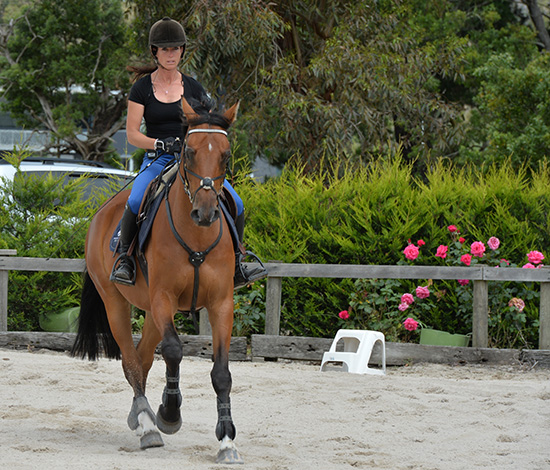
“Keep his shoulders straight and the neck in the centre of his chest, and gradually as he has an understanding of half halt, and the longitudinal balance and flexion improves we start lateral flexion , so we will have more influence over the left hind leg.”
“When you shorten him Caroline, you are actually shortening him from the back not the front, that’s what you’ve got to think about. It is the same as what you would do when you wait for a fence, you think about waiting with your body, and wanting the horse’s hind leg to keep active and forward thinking to the fence, you are just containing the spring. So now wait with your body and cluck. That’s where the saying comes that you shorten a horse from the back, and you can only know how much leg to use in a half halt, if you decide on what tempo you want to travel.”
“You decide on the tempo you want the horse’s hind legs to travel on and that’s how you know if you just need a cluck, leg, or you need the dressage whip.”
Caroline works on the basics under Michelle’s guidance
I commented to Michelle that she was using a technique beloved by one of the more controversial modern dressage trainers – with your half stop go, you are using one of Sjef Janssen’s techniques. Sjef had a thing that you can’t push a horse into the halt with the leg, but when I asked, how do you stop them dropping their hind ends out in the halt, he said, you have to always have them thinking about coming immediately out of the halt, then they will get their hind legs under them…
“I love half transitions, and I think what is does is teach the rider to read the hind leg. If they are ready to change their mind, the minute the hind leg gets slow, then the rider’s mind is not on the bridle, it is on the hind leg. You can’t have a good halt if the horse is not thinking forward. If you are having to over-use leg to keep the hock under you, the horse is behind your leg in the first place.”
Caroline: “At home I have three canter poles and every time I took my leg off, he went trot – this is going to help…”
Michelle agrees: “It will help him keep his own natural zest of forward thinking. You see riders who are busy, busy, busy, and as soon as the horse does something right, they take all the aids away, and pat it, and let the horse fall in a big heap. You should be able to sit silent, and at that point of silence, the horse should not instantly fall behind you. George Morris said to us, a long time ago, I want you to wait at the vertical with no leg. And everyone said, but the horses will fall into a trot. But if you are pushing into every transition, you are actually pushing the horse away from you, instead of containing the zest and speed. Impulsion should be containing zest and energy. This is what is needed for these big Warmbloods that do big-and-slow well, they have got to be able to be quick enough behind, so you can sit against them and they can still produce their power when they shorten.”
“Everyone knows they have to shorten the big Warmbloods, but when they try to do it, the hind end gets slower and slower, so the back gets flatter and flatter, and lower and lower. It is a short canter but it has no substance or power, no jump about it.”
Lateral tools…
Michelle is also helping Caroline explain to Finn that he has to be able to move away from the rider’s leg…
“Last week we started on turns on the forehand. At the moment, Caroline is doing lots of transitions to build up strength in the horse, and to teach him the half halt, but we also need to start teaching some lateral tools at the walk, and my first basic lateral tool that I love, is the turn on the forehand.”
more follows
“One of the main things a rider should think about in the turn on the forehand is separating arm and body aids, from leg aids.”
“A lot of people have difficulty doing that, if I ask them to use their right leg, there is immediately tension in their right arm and the right side of their body. The horse has to move off the right leg, and the two reins keep the same receivership as you would in your transitions. We are looking for equal weight in two reins and the horse learns to step away from your leg. Once he is starting to get the concept, I like to take it to the walk, because otherwise in halt there is just the tendency for one hind leg to just step across to the other hind leg, ideally we want him to step under and forward, and that comes from doing the exercise in the walk.”
Separating arm and body aids from leg aids is an extremely important lateral tool
“As you walk forward, and you put the right leg on him to get him to step forward and underneath himself, you will find he wants to run through the bridle. We’ve spent a week or so trying to teach him to go forward from the leg, now it can get a little confusing for him when we are asking for something that’s a bit different, even though we still want him to go forward. When he puts his head up and wants to run through the bridle, it is very important, what he feels from your hand. Keep the same feeling in the hand so he has confidence in the bridle, keep both reins equal, and ask for one step in and forward of his right hind leg, and then go straight.”
“See there he swung straight back again, so I want when you get him to take that step under and to the side, don’t go back on your original line. Stepping under that one step, you have created a new line, and you should walk him straight forward from that. It is really important when you finish an exercise like this that you have a purposeful line that you want to take them on, it creates the natural forwardness of the hind leg – whereas if you come out wriggling and not really knowing where you want to go, you are not going to create that forwardness. Everything should be about you knowing where you want to put the hind legs, at what speed, and where you want them to go. So walk up here, do a step away from the right leg, one step, slow the walk , there is your half halt working, move the right hind and then walk straight forward from that – whatever line you are on, don’t go back to the track. Now do another one step, and ride another angle, perfect, go forward from that.”
“You need to keep doing that until it becomes really easy, right hind, and straight forward. If you find that he goes too far, use a line to ride out of it, don’t block him too much with the outside rein, because then you just get too much of a twist in the poll. Right hind, find a line… good. Duplicate the exercise on the left also.”
next improving the canter
Improving the canter…
“Caroline’s great, we’ve worked together for a long time, and she does her homework, so that at the next lesson we can make some progress. What we are doing is just every-day gymnastics. When we start cantering stay on quarter line to quarter line, I just want you to work on his head being the centre of his chest, and really riding the lines with your eyes to keep him straight.”
“Your priority, because we know he is slightly on two tracks, is to control the shoulders. Don’t go inside leg to outside rein, that is too advanced, you would only get him stiff and put him out-of-balance, so if you are going along the long side and you feel he is starting to push his quarters in, I’d rather you bring the shoulders to meet the quarters. Open the rein to bring the shoulder across. You feel like you want to do the opposite because it feels like he is falling in, but he is not falling in with the shoulder, he is falling in with the ribs behind you, and if you try to put the shoulders too far to the outside, you are going to make him more crooked.”
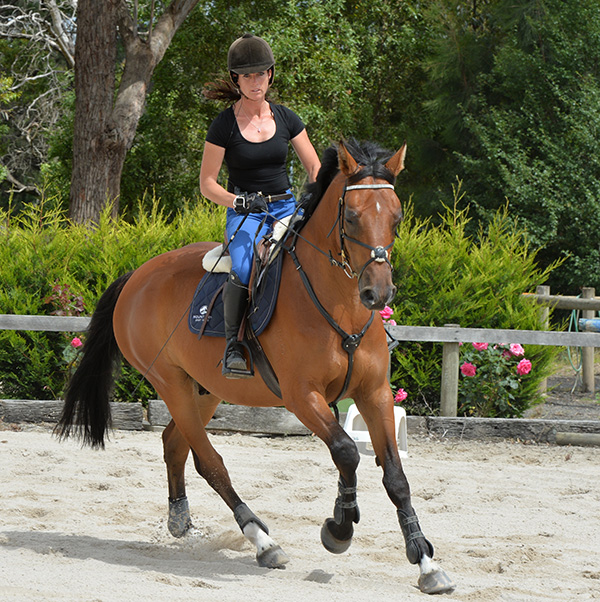
Next up, working on the canter…
“When you feel the horse is out of balance in the circles, that is because the horse doesn’t understand the half halt well enough yet, so your influence over his centre of gravity is limited, and he falls on his front legs.”
“On the next long side, lengthen the canter, and feel what his balance is like, what the straightness feels like, come out of the saddle and have a little gallop – tap him up – now come back with your body… You can see he is still not in front of Caroline’s leg, he is green.”
“Get out of the saddle, test that he is in front of the leg, little tap and see what response you get – much better – now come back slowly with your body. Now we are going to shorten the canter a little, but as you go to shorten it, read the hind legs, and if the hind leg gets slow, that tells you that you need to go forward again. Now let’s come onto a large circle, and think about the shoulders on the circle, sit tall but not heavy, legs long, try a little half halt, that was good, little half halt again and bring the shoulders around. Very good, straight line and go for a little gallop. Now just use your body to balance, good, gallop again, sit up, come together again, use your body.”
“Back to trot and let him catch his breath. Let him stretch further down, don’t kick every stride though, let him down, nice , if he falls behind you, a little tap.
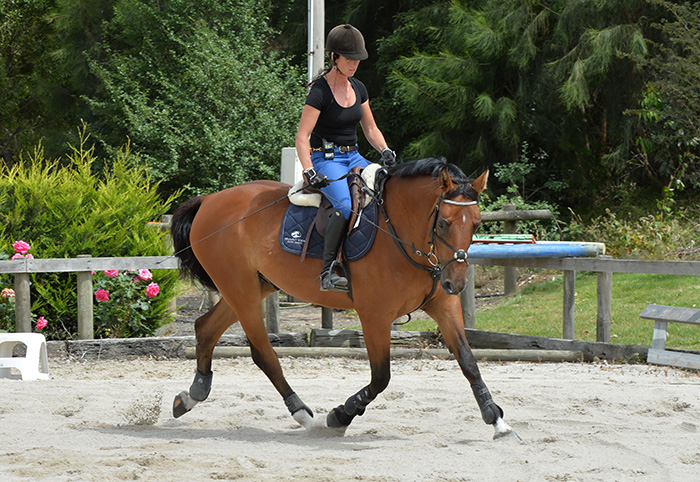
Now up the long side, look at the line, and as you go to walk, he’ll feel like he wants to flop, and if he does, change your mind, go back to trot. Do it again, go to walk, and trot out. When you are finishing, ride him a little longer, with transitions, it is the best way to read the horse’s body, because your mind is off the bridle, you can focus more on what the horses body is doing.”
Starting jumping…
“With the jumping when we start off, I try to keep it very simple. I don’t want to build complex grids , because the canter is not good enough. If you build complex distances and expect them to give massive jumps, they don’t have the strength in the canter to produce that jump – that’s when you start to get problems, weak off the ground, shifting across a fence , stiffness in the jump. I believe, that ultimately what produces a good jump is consistent arrival at the fence. Consistent balance, good pace and line promotes a consistent arrival.”
“Of course we want to teach them how to jump, today I will put a pole here before the fence and I’ll make it three strides, but I won’t say this has to be 12 yards or 13 yards and he has to work to that program, because I will alter it to suit where-ever his canter is at, what level of education he has in the canter at the moment. The last thing I want is for Caroline to jump in and have to swing off the bridle and manufacture a length of canter he cannot supply at this stage, he is not adjustable in his canter yet – to do it in front of a fence is a whole new level of difficulty.”
His dad and his mum and his grand-parents probably put the jump there anyway…
“Exactly, what they need is for us to get them to the fence well. That is the beauty of buying a nice horse, then our job is to help the horse be as athletic as possible and be able to work with its own natural zest and natural ability. Our job is to help it arrive at the fence the best way possible – the rest is the horse’s business. When you start to try and manufacture jumps, you actually start to destroy them.”
“Take for example a straightness problem at a jump… I saw someone recently put up V-poles, I’m not saying that I do not use them, but the V-poles were to stop the horse falling right, but when the horse landed, it cut the corner to the right badly anyway, and was not corrected, so what was the point of the V-pole? That’s why we try to get the horses straight in the first place. Caroline’s horse was falling out through his right shoulder, so at our very first fence, what did he do? He went to the right – it’s 100% predictable. Straightness is an on-going challenge with every horse, but a very important thing to correct.”
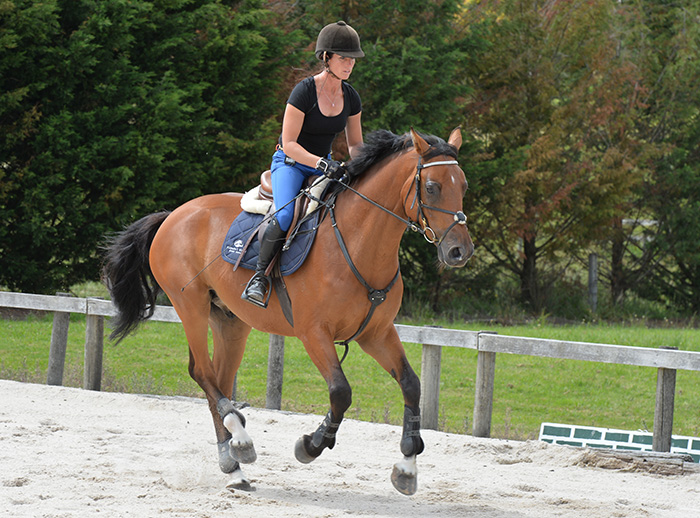
“Our jumping exercise is very simple, just a pole down to a fence, 13 yards (just take 10% off for meters). I like it down the centre line for the young horses, then the rider can focus on the straightness, and that is our first priority, and to go in whatever direction lead you land on, however if the horse is drifting to the right, then we would land and go in the opposite direction – I like them to land and teach the horse to keep cantering.”

“That is the other important thing, because eventually we want to put a full course together, so when you land, you have to remember that your landing stride is your first stride to the next fence, so we are already teaching him to hold the balance, land, go straight. Sometimes people jump one fence and they let the reins drop and the horse falls out of balance.”
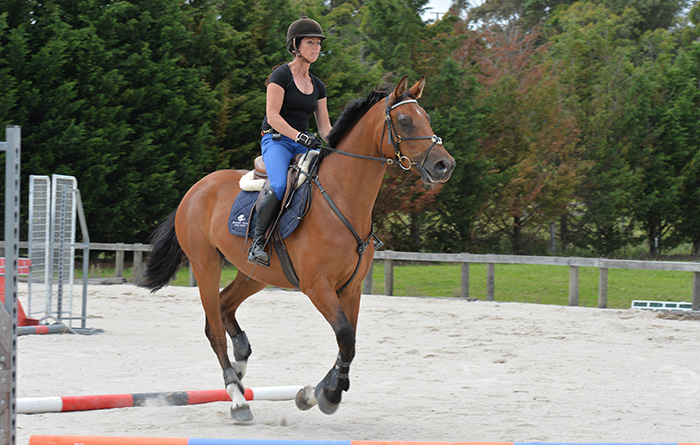
And the youngster is a bit surprised at the new fence, complete with a couple of observers and a photographer…
“Good, when he is spooky, don’t get after him, just a cluck. Your body stays neutral, and keep him straight, straight, straight. You can see when he gets spooky, his body goes flat and he trots. I am going to make the distance a bit longer, it might help Caroline to keep him cantering.”
“I’m not into manufacturing the jump. We’ve seen this horse jump, we know he can jump. If he makes a mistake, Caroline’s job is just to keep him balanced and ride forward, let him learn. Keep it simple – concentrate on going straight – and her position is not hindering the horse in any way. You can see his balance is on his front legs at the moment, and that will change as Caroline works on his longitudinal balance.”
“Come on the circle – and you can see that the easy thing to do, is think he is not showing enough jump today, let’s stick it up but I have no intention of doing that. We know the horse is a nice jumper, but even if we didn’t know that, the only way it is going to become a nice jumper is to travel well to the fence. Caroline can feel what is going wrong, he is hard to balance and adjust in his canter. His jump under saddle will improve as he learns the half halts, then Caroline can arrive at the jump with a better quality canter. ”
“That was really good. Now walk.”
And the horse starts to grab the rein and toss his head…
“You keep your hands still through the resistance, still hands, elastic arms, now cluck, keep moving forward to the bridle. He is just finding his way from leg to hand. Do it again, trot, sit to walk, you be the quiet one, when you get that resistance, you be the still one with your hands. He’ll wobble, so you think about the straightness and moving forward. Caroline has great feel, she has learnt to have contact without closing the front door.”
“Try it again, trot, go to walk, change your mind, and when you change your mind, don’t get faster than the rhythm you start with. One /two, one/two, change your mind, but don’t speed him forward, just as much leg as takes you back to the rhythm you had before. Remember the metronome, otherwise, too much leg, too much speed, will cause too much hand. Now walk, perfect, and you needed no leg in that walk transition to keep the motor going forward.”
“Just for the fun of it, pop him over the flower jump. Long approach, canter down on the right rein. Hands still, body still, if he falls behind the leg, a little cluck. What a nice attitude… now remember the half transition, walk, give, and when he is tired and you can feel him wanting to roll down, don’t try and lift him up, give him the longer rein, and do your half transitions on the longer rein, and he will balance himself out. It is really tempting to pull his head up, but don’t try and do that, let him find his balance. He’s got a big body, he’s got a big carcass, if his legs are not underneath him, there is no way he can carry himself. He is going to develop into a big powerball.”
more on developing feel follows
Establishing the foundation
“There has to be a core understanding of what you are trying to do with a horse’s body. That doesn’t mean you can’t be competitive, but the fact is, it is not like tennis or golf. It is more like surfing. I was watching my daughter, Zoe surfing the other day, and she was reading the waves, she is quite emotional about how you’ve got to feel the wave to ride the board. The tennis racket is a fairly solid little item, it is not going to change but in our sport, it is not just about the mechanics – we must lengthen, we must shorten, we must jump the jump – what we are trying to do, is ride the athlete. If we have no understanding of how the athlete’s body is working, you are not going to get there.”
“You’ll hear riders say, this horse is one sided, I’m going take it more left, to pull the left rein until it gives to me. The horse will never give. It doesn’t matter how much you pull, it will never give. It’s more likely to lock up its jaw, to lock up its back legs and become more solid against the bit. It’s natural for a horse to lean on something. But if I hold them long enough, surely they will stop leaning? Have you ever seen them in a float? They don’t learn from you pulling – what we are trying to get across to the horse, is to perform in a certain way, and to make that job easier for him, so there is more harmony, you have to understand how his body and mind works. Train in a way that the horse finds easier, because training is about convincing the horse that it is the horse’s idea.”
“Okay we are trying to persuade it that it is the horse’s idea, but there’s no way you can do that if you are going against the way the horse’s mind and body works – that’s when you get resistance.”
“I’m not saying we don’t get resistance, we do, but if you are thinking about it, at the point of resistance, you can feel which part of the horse’s body is putting in the most resistance. Then you find where and why the resistance is occurring – okay it’s because he is throwing his left hind leg away from his body, or it is getting wide behind, it’s tense, or whatever the body might be doing, learn to feel it . Then you can go back to the drawing board and fix that resistance, and while the resistance may show in the mouth, that is not the source. I often say the horse’s hind legs reflect the rider’s hands. The hind leg that we want for a jump is the same hind leg that you want for dressage, you want that natural zest, you want all that energy, but it has to go somewhere, the hind leg goes into the corners of the mouth.”
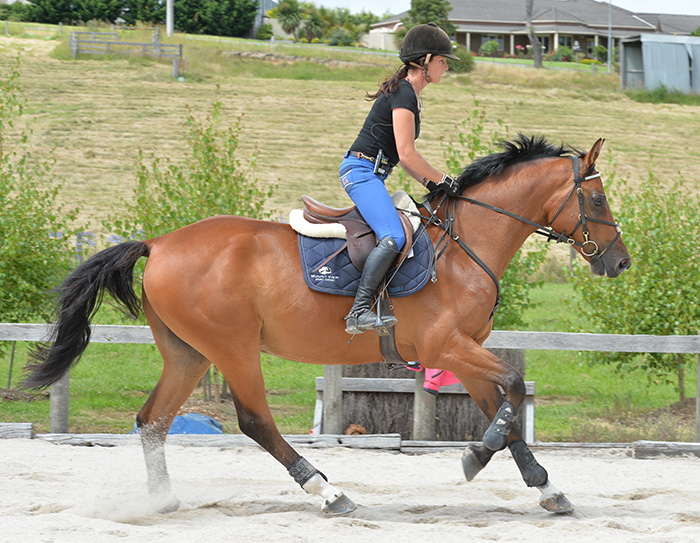
“If your whole strategy is getting rougher in front, trying to manufacture things from the front, then the hind leg will always stop because it won’t want to go there. I now it takes a lot longer, but if you get it right in the beginning, then all the rest will be so much easier and more pleasant for the rider – and the horse.”
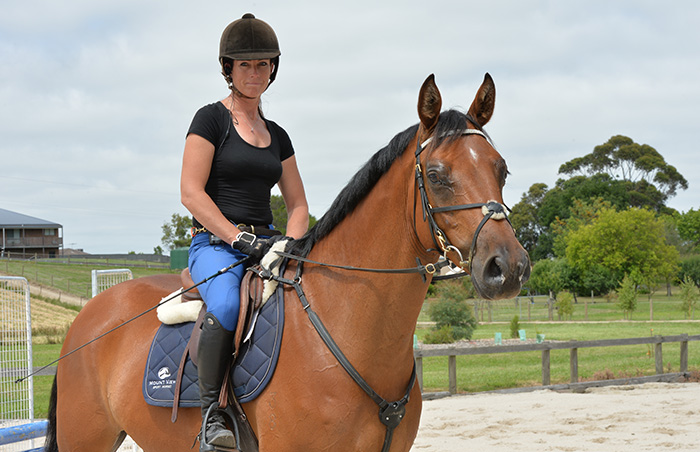
There are many top European stallions available from International Horse Breeders, go to www.ihb.com.au
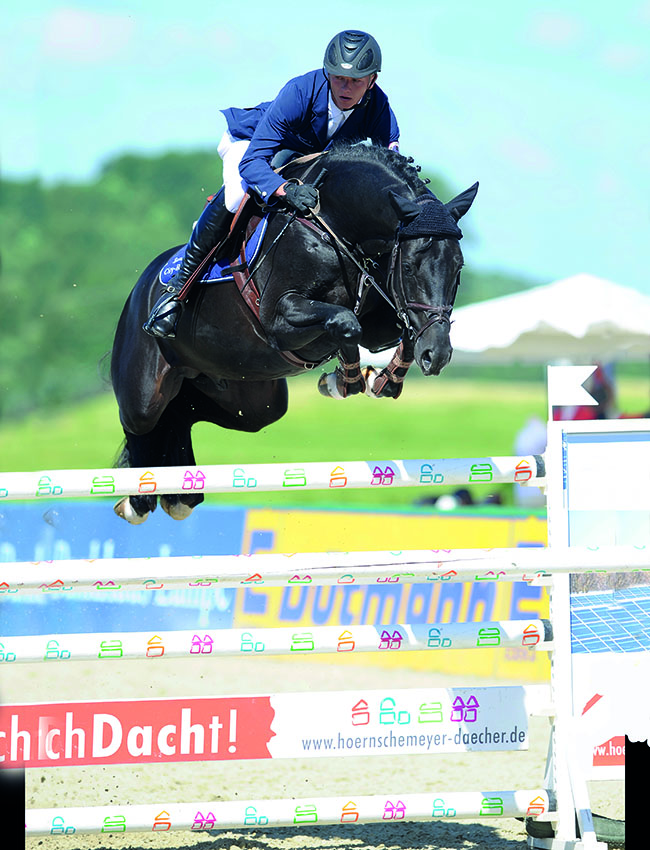
Like Diarado and..
Balou du Rouet and many more!

